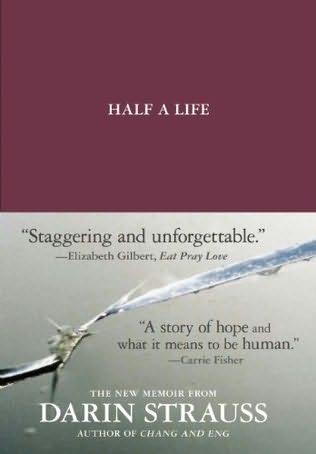Posted by Nick Curley
McSweeney’s; 208 pp; $22.00.
In every teenage life moments emerge which, were they to have gone a bit differently, would inexorably lapse one’s life into bad decline. You eat the blue pill instead of the red, and before you can make amends, the proverbial rabbit hole closes in tight. Nowhere do such tragic mishaps occur more often than on the open road, so tempting to young drivers while demanding split-second precision from them. Half a Life, a new novella-length memoir by acclaimed novelist Darin Strauss (Chang and Eng, The Real McCoy) details one such affliction: the true story of how Strauss, just weeks before graduating from North Shore High School in Long Island, crashed his car into a classmate who had without warning, sharply turned her bike into two lanes of traffic. Sixteen year old Celine Zilke died instantly, and while the accident’s investigation absolved Strauss of any negligence or wrongdoing, it is only the beginning of Strauss’ lifelong preoccupation with the collision and his lingering trauma thereafter. Half a Life proves a meticulous and often devastating study of grief, loss, and the plight of human memory. “We can try our human best in the crucial moment,” writes Strauss, “and it might not be good enough.” Within a taut structure Strauss wrestles with the dilemma that storytellers from Plato to Hitchcock have confronted: the queasy sensation of being met with terrible problems that are not our fault, yet refuse to relent.
The structure of Strauss’ account carries the ether of a dream state. Several chapters are but a paragraph long. Anecdotes end suddenly, without the comfortable conclusions or tidy summations that lesser memoirs of grief indulge. The result stylistically is reminiscent of Joan Didion’s early novels, namely Run River and Play It as It Lays, as well as her own memoir on grieving, The Year of Magical Thinking. These are books in which characters changed only upon realizing their predicaments were damn near permanent. Like Didion, Strauss pulls no punches: despite its somber subject, this is a book largely without self-pity or morbidity. Strauss is cagey enough to know what the reader is thinking, and earnestly attempts to meet such judgments with frank candor. Life, to Strauss’ surprise and often chagrin, carries on: his friends and family quickly work to put him at ease in the days and months following the accident. Much of Strauss’ conflict stems from within: unsettling suspicion that he is not feeling the right emotion at the right moment, and self-induced pressure to express grief in showy, public ways to the audience of his peers. He goes off to college and attempts to reinvent himself, only to find himself emotionally frozen and bewildered by his unwillingness to confront the conflictions of Celine and her death. He goes on bad dates that leave him baffled. He has strange interactions with Celine’s family that only further confuse and conflate the issues. Particularly as the events surrounding the crash play out in the book’s first half, Strauss expertly couples dread and hope into crashing waves: each overtaking the other unexpectedly, each incomplete without the next. We are not spared from Strauss’ sour moments of caustic self-absorption, thereby preserving his realizations as epiphanies. The result is a dissonant tone that hums with the ring of truth.
Strauss’ internalized approach grants the book but a few big set-pieces of dialogue in which major players can engage one another. The book’s best scene is a nail biter of a courthouse interrogation, as the Zilkes’ lawyer besieges Strauss with questions that are downright brutal, even when they read as a futile grasp at straws from a cash-grabbing bully. The scene’s aftermath outside the judge’s quarters, in which Darin’s father has a brief but remarkable encounter with Celine’s own dad, illustrates an array of complex human behaviors. It is a confrontation wrought with empathy, irony, sarcasm, anger, kindness, and ambiguity all at once: a deeply satisfying, expertly captured snapshot of the kind of ethical justice that we for both better and worse expect from our judicial system. This short passage shows people truly devastating one another, as their tension and unspoken nuances brim over the pages. It’s a clash of emotions that plays and replays in the mind’s eye for days on end, and causes one’s heart to race just by remembering it.
Yet this is not a book about crime, nor is it about punishment in the corporal sense. Instead, Strauss’ sentence proves to be an adulthood of self-castigation. He thinks of Celine daily for many years following his acquittal. Yet to say that he is haunted by her would be imprecise, for the author never lets Celine become a hackneyed ghost or trope. Strauss consciously, explicitly respects his reader, outlining in later passages how he came to write Half a Life, and why he wrote it the way that he did. While his unwillingness to fashion a Hollywood ending is admirable, this gradual finis de écriture makes the book’s final forty pages fade and fizzle. It’s unfortunate that the story’s meditative finish lacks the veracity and punch of its earlier scenes. Strauss comes to realize that writing about Celine and the incident serves as a kind of testimony, allowing for ratifying self-acceptance. In spite of some petering prose, the book’s resolution rightly suggests that grieving is by design an unending process. We persevere amidst death not thanks to “closure”, but thanks to introspection and acceptance of that which cannot (and need not) ever fully close. As Strauss emerges from the icy depths a grown man, with a wife and children of his own, Half a Life plants the notion that mortality, our one fragile certainty, is not to be feared or resented: rather, it’s the source of all that we must value and savor.

